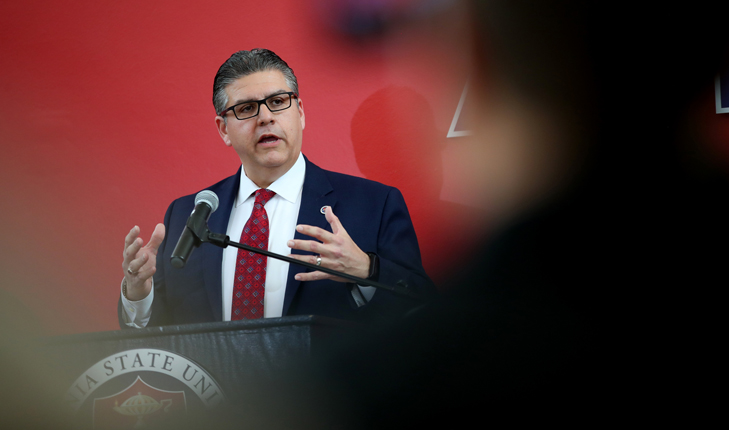I sense that 2019 will be a hopeful yet sobering year on the homelessness front in Fresno.
City Hall announced in early December that the necessary steps have been taken to acquire more $12 million in one-time state funds to battle homelessness in the region.
If all goes according to plan (never a sure thing when dealing with Sacramento), Fresno would receive $3.1 million and the Fresno-Madera Continuum of Care would get $9.5 million. It’s all a part of the state’s Homeless Emergency Aid Program and Senate Bill 850.
The latter requires local governments to declare a shelter crisis in their jurisdictions. Fresno County and Fresno City Hall have done this.
Said Mayor Lee Brand in a written statement:
“Homelessness is the single most significant quality of life issue facing our community, which is why I launched the Street2Home initiative this year, a county-wide collaboration to address homelessness compassionately and intelligently. We all know the best way to stop the cycle of homelessness is to put a roof over someone’s head, whether it’s permanent or temporary. This funding will help us continue our successful efforts to connect Fresno’s homeless to the resources that will bring comfort and stability to their lives.”
Fresno County Supervisor Sal Quintero earlier this year joined the Mayor in the leading the local homeless initiative.
Part of the funding backstory, as you may recall, was the joint lobbying efforts last summer by Mayor Brand and other big-city mayors in California to get more state money for homeless programs. As the Fresno City Hall news release notes, one of the hurdles that each city/region must clear before getting the money is implementing a planning process that determines how the money will be spent.
When it comes to plans for combating homelessness, Fresno has had plenty. That’s no knock on local leaders. Homelessness is a tricky problem.
The latest plan, as the Mayor noted in his statement, is “Street2Home Fresno County: A Framework for Action.” It runs to 56 pages and covers familiar territory for anyone who has followed public policy over the last 20 years.
The plan notes that there were a total of 1,834 homeless people (sheltered and unsheltered) in Fresno and the rest of the county in 2018, an increase of about 5% from 2017. However, the number of chronic homeless people dropped nearly 38%, from 622 in 2017 to 451 in 2018.
The plan offers four key courses of action, or “pillars,” and 13 key recommendations. Among the recommendations: Educate and engage the entire community in solutions; preserve affordable housing options; create new, low-barrier crisis housing options; aggressively expand non-traditional permanent housing options.
Among the “pillars,” I found No. 2 to be most interesting: “Reduce inflow to homelessness.” America is a big place. It’s a place of individual liberty. People often act irrationally. Life can throw anyone a sudden and devastating curve. That has always been the reality. That will always be the reality. How, then, do we reduce the inflow to homelessness?
I understand Pillar No. 2 to be about the improvement of the region’s system of homeless logistics. Better and faster use of resources would divert many potentially homeless individuals/families into stable housing before they land on the streets or in an emergency shelter.
All of us in Fresno and the rest of the county hope “Street2Home Fresno County” and the latest homelessness plan is a success. But that brings me to my reasons for caution.
Christopher F. Rufo, writing for the “City Journal” online site, says Seattle “is under siege.” The city and King County have about 11,000 homeless of all types, spends more than $1 billion annually on homeless services, yet the problem only grows bigger and more volatile.
Rufo writes that “the real battle isn’t being waged in the tents, under the bridges, or in the corridors of City Hall but in the realm of ideas, where, for now, four ideological power centers frame Seattle’s homelessness debate. I’ll identify them as the socialists, the compassion brigades, the homeless-industrial complex, and the addiction evangelists. Together, they have dominated the local policy discussion, diverted hundreds of millions of dollars toward favored projects, and converted many well-intentioned voters to the politics of unlimited compassion. If we want to break through the failed status quo on homelessness in places like Seattle—and in Portland, San Francisco, and Los Angeles, too—we must first map the ideological battlefield, identify the flaws in our current policies, and rethink our assumptions.”
Rufo’s description of “addiction evangelists” is especially riveting. Simply put, there’s a growing belief among some homeless advocates and public policymakers that government has a duty to spend taxpayer funds to make sure drug addicts service their addictions in what is considered to be a safe and sane way. In other words, the advocates/policymakers want to normalize and legitimize a behavior that often leads to homelessness, despair, violence and death. They push addiction normalization as a means of “harm reduction.”
Rufo writes: “The question almost never asked about harm reduction is: Harm reduction for whom? Whatever help they might offer addicts, public-consumption sites do tremendous damage to businesses, residents, and cities at large.” (Emphasis in the original.)
My gut tells me the “realm of ideas” described by Rufo is coming to Fresno, and coming fast.










